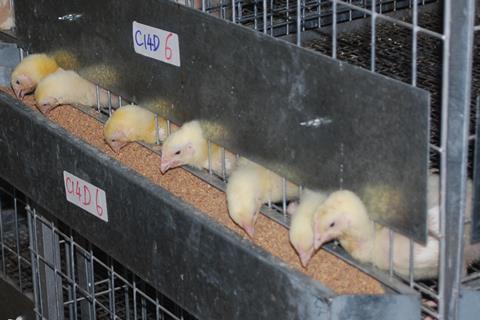A novel bacterial strain added as a supplement to broiler chicken feed not only boosts their growth rate, but significantly alters their caecal microbiome, enhancing the capacity for microbial amino acid and vitamin biosynthesis, a new study shows.
The research by a team at the University of Queensland is outlined in the paper ‘Enhanced meat chicken productivity in response to the probiotic Bacillus amyloliquefaciens H57 is associated with the enrichment of microbial amino acid and vitamin biosynthesis pathways’, published in the Journal of Applied Microbiology, an Applied Microbiology International publication.

The novel bacterial strain Bacillus amyloliquefaciens H57 had previously been shown to reduce clostridial enteritis and coccidiosis in chickens, according to corresponding author Dr Peter Dart - but its benefits don’t end there.
Alternative to antibiotics
“The use of antibiotics as a growth promoter supplement in animal diets has either been banned or voluntarily withdrawn from use in many countries to help curb the emergence of antibiotic-resistant pathogens,” he explained.
“Poultry feed supplements such as the probiotic B.amyloliquefaciens H57 are an alternative. We investigated H57 effects on the growth performance and microbiome-associated metabolic potential in broiler chickens.”
The study saw H57 added to the feed of Ross 308 broiler chickens over a 21-day period, with growth performance and the caecal microbiome composition both measured.
The experiment was conducted in a temperature-controlled room with 288 one-day-old male broiler chicks randomly assigned to one of four treatment diets based on sorghum or wheat, supplemented or not with H57 to provide at least 109 cfu H57 per bird per day over 21 days.
Experiment timetable
Chicks were assigned to six pens per treatment, each with 12 chicks. On day 13, caecal contents were collected from one randomly selected chicken from each of five randomly selected pens per treatment. Their microbiomes were studied with next-generation metagenomic DNA shotgun sequencing, while the performance and DNA sequencing data were analysed with various statistical and bioinformatics tools.
The study found that the H57 treatment significantly enhanced the growth rate and feed intake of the birds, with both diets. There were significant differences in overall microbial metabolic functional potential between the control and H57-supplemented birds for both sorghum and wheat-based diets, indicating that H57 supplementation altered the functional capacity of the caecal microbiome.
Among 15 differentially abundant pathways enriched in the caecal microbiota of birds fed the H57 sorghum diet, seven pathways were related to the biosynthesis of essential amino acids and similarly, five pathways for the wheat-based diet plus H57.
Metabolic pathways
Another important group of metabolic pathways enriched in the H57 wheat-based diet is vitamin synthesis, particularly of the B-complex group, essential cofactors for enzymes in intermediatory metabolism.
A total of seven metabolic pathways responsible for the synthesis of thiamine (vitamin B1), riboflavin (vitamin B2), biotin (vitamin B7 or vitamin H) and folate (vitamin B9) were significantly enriched by H57.
“H57 is a potential feed supplement alternative to antibiotic growth promoters. There is a growing interest in low protein diet formulation in the poultry industry based on environmental sustainability and cost reduction concerns,” Dr Dart said.
“The approach is to formulate low crude protein diets with specific synthetic amino acid supplements to balance the amounts of specific essential amino acids in the diet.
Boosting chicken diets
“Our study opens the possibility of supplementing low protein chicken diets with selected probiotics to enhance microbial amino acid synthesis. Similarly, a diet deficit in vitamin B can impair growth and reduce feed use efficiency. H57 can indirectly improve the production of these vitamins in the caeca by enriching the intestinal environment with the required metabolic pathways to produce vitamins.”
The next step should be to quantify the amount of both amino acids and vitamins produced by supplementing poultry diets with probiotics such as H57, locating where they are produced in the gut intestinal tract and taken up,” Dr Dart said.
“In addition to inducing the caecal microbiota to produce amino acids and B-vitamins, Bacillus amyloliquefaciens produces a large range of extracellular metabolites eg. enzymes such as α-amylase, proteases, cellulase, and xylanase; antimicrobial and antifungal lipopeptides eg. surfactin, fengicin, bacillumycin D, iturin A, polyketides eg. macrolactin, difficidin, bacillaene, and bacteriocins.
“It is not known if any of these compounds benefit poultry nutrition and how they might influence poultry GIT microbiome composition and function, especially related to the changes described in this study.”
Dr Yadav Sharma Bajagai led the project with hands-on involvement from the other authors. The study was supported by an Australian Research Council Linkage Project Grant between the University of Queensland and Ridley AgriProducts. Dr Bajagai was a recipient of an Australian Government Endeavour Scholarship.
‘Enhanced meat chicken productivity in response to the probiotic Bacillus amyloliquefaciens H57 is associated with the enrichment of microbial amino acid and vitamin biosynthesis pathways’, published in the Journal of Applied Microbiology.







No comments yet